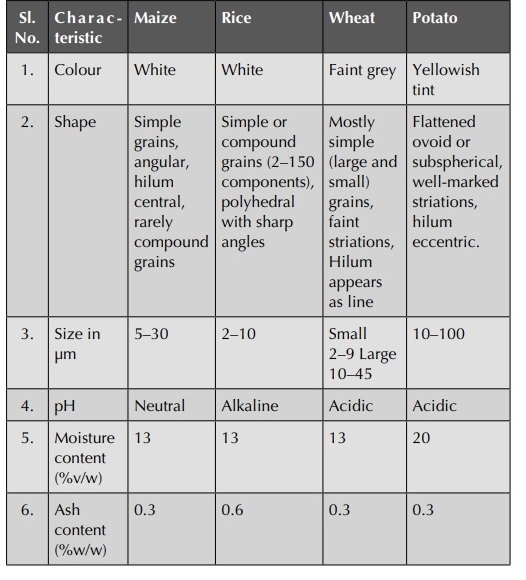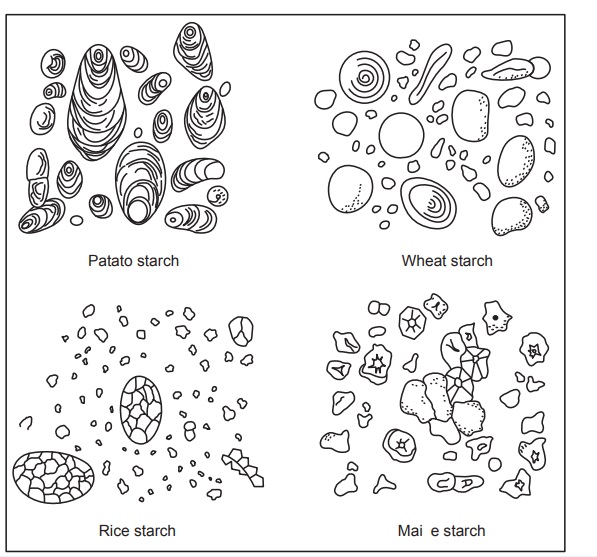Cell Contents
| Home | | Pharmacognosy |Chapter: Pharmacognosy and Phytochemistry : Morphology of Different Parts of Medicinal Plant
In pharmacognosy, we are concerned with the cell contents which can be identified in plant drugs by microscopical and physical tests. These are either food storage products or the by-products of plant metabolism and include carbohy-drates, proteins, lipids, calcium oxalate, calcium carbonate, tannins, resins, etc.
CELL CONTENTS
In pharmacognosy, we are concerned with the cell contents
which can be identified in plant drugs by microscopical and physical tests.
These are either food storage products or the by-products of plant metabolism
and include carbohydrates, proteins, lipids, calcium oxalate, calcium
carbonate, tannins, resins, etc. Some
of these cell contents of diagnostic importance can be briefly described as
follows.
Starch
Starch is present in different parts of the plant in the
form of granules of varying size. Starch is found abundantly in fruit, seed,
root, rhizome and as smaller grains in chlorophyll containing tissue of the
plant such as leaf. Starches of different origins can be identified by studying
their size, shape and structure, as well as, position of the hilum and
striations. Chemically, starches are polysaccharides containing amylopectin
and β-amylose. Starch turns blue to violet when treated with
iodine solution.
Starches of pharmaceutical interest are obtained from maize,
rice, wheat and potato. These starches can be differentiated from each other
by microscopical examination. A comparative account of their macroscopical,
microscopical and physical characteristics is given in the Table below. For
purpose of microscopical studies, the powder should be mounted in Smiths starch
reagent containing equal parts of glycerin, water and 50% acetic acid.
Table : Characteristics of some starch grains

1)
Shape—Ovoid, spherical, sub-spherical,
ellipsoidal, polyhedral, etc.
2)
Size—Dimensions in μm.
3)
Position of hilum—Central, eccentric, pointed,
radiate, linear, etc.
4)
Aggregation—Simple, compound; number of
compo-nents present in a compound grain.
5)
Appearance
between crossed polaroids.
6)
Location—Loose, present in type of cell and
tissue.
7)
Frequency—Occasional, frequent, abundant.

Aleurone Grain
Protein is stored in the form of aleurone grain by plants.
Aleurone grain consists of a mass of protein surrounded by a thin membrane, and
is found abundantly in the endosperm of the seed. The ground mass of protein,
however, often encloses an angular body (crystalloid) arid one or more rounded
bodies (globoids).
Defat thin sections containing aleurone grains and treat
with the following reagents.
1.
Alcoholic picric acid—Ground tissue and crystalloid are stained yellow.
2.
Millon’s reagent—Protein is stained red on warming.
3.
Iodine solution—Only crystalloid and ground
substance are stained yellowish
brown.
Calcium Oxalate Crystals
Calcium oxalate crystals are considered as excretory
prod-ucts of plant metabolism. They occur in different forms and provide
valuable information for identification of crude drugs in entire and powdered
forms.
1)
Microsphenoidal or sandy crystals—Belladonna.
2)
Single acicular crystals—Cinnamon, gentian,
3)
Prismsmatic crystals—Quassia, hyoscyamus, senna,
rau-wolfia, cascara.
4)
Rosettes crystals—Stramonium, senna, cascara, rhubarb.
5)
Bundles of acicular crystals—Squill, ipecacuanha.
The sections to be examined for calcium oxalate should be
cleared with caustic alkali or chloral hydrate. These reagents very slowly
dissolve the crystals, so the observa-tion should be made immediately after
clearing the section. The polarizing microscope is useful in the detection of
small crystals.
Mount the cleared section or powder in the following
reagents and observe the crystals.
1.
Acetic acid—Insoluble
2.
Caustic alkali—Insoluble
3.
Hydrochloric acid—Soluble
4.
Sulphuric acid (60% w/w)—Soluble, on standing replaced
by needles of calcium sulphate.
Calcium Carbonate
Aggregates of crystals of calcium carbonate are called
‘cys-toliths’, which appear like small bunches of grapes in the tissue. Calcium
carbonate dissolves with effervescence in acetic, hydrochloric or sulphuric
acid. When treated with 60% w/w sulphuric acid, needled shaped crystals of
calcium sulphate slowly separate out.
Fixed Oils and Fats
Fixed oils and fats are widely distributed in both
vegetative and reproductive parts of the plant. They are more con-centrated in
the seeds as reserved lipids. Fixed oils occur as small refractive oil
globules, usually present in association with aleurone grains. Fixed oil and
fat show certain common characteristics and respond to the following tests:
1)
They
are generally soluble in ether and alcohol with few exceptions.
2)
1%
solution of osmic acid colours them brown or black.
3)
Dilute
tincture of alkanna stains them red on standing for about 30 minutes.
4)
A
mixture of equal parts of strong solution of ammonia and saturated solution of
potash slowly saponifies fixed oil and fat.
Mucilage
Mucilages are polysaccharide complexes of sugar and uronic
acids, usually formed from the cell wall. They are insoluble in alcohol but
swell or dissolve in water. The following tests are useful for the detection of
mucilage in cells.
1.
Solution
of ruthenium red stains the mucilage pink. Lead acetate solution is added to
prevent undue swell-ing or solution of the substance being tested.
2.
Solution
of corallin soda and 25% sodium bicarbon-ate solution (alkaline solution of
corallin) stain the mucilage pink.
